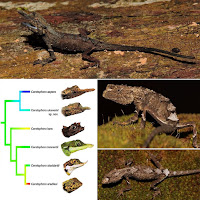 |
| Ceratophora ukuwelai Karunarathna, Poyarkov, Amarasinghe, Surasinghe, Bushuev, Madawala, Gorin & De Silva, 2020 Ukuwelas’ Rough-horn Lizard | උකුවෙලගේ රළු අං කටුස්සා || amphibian-reptile-conservation.org |
Abstract
The genus Ceratophora (horn-lizards) comprises six species, all of which are endemic to Sri Lanka. Herein, a new species of Ceratophora is described based on morphological and molecular evidence. The new species is restricted to the Salgala Forest (~300 m asl elevation) in the Kegalle District of Sri Lanka, which is in the northern part of the wet bioclimatic zone. The new species most closely resembles Ceratophora aspera Günther, 1864, but can be distinguished from it by body proportions, number of paravertebral and ventral scales, and ND2 mtDNA data. Complete morphological description of two syntypes of C. aspera are also provided, in addition to a key to the species of genus Ceratophora. The phylogenetic relationships and evolution of rostral appendages in Sri Lankan agamid lizards are discussed in light of new data. According to IUCN Red List criteria, the new species is categorized as Critically Endangered due to its range-restricted habitat. The major threats for this species are habitat loss due to expansion of commercial-scale agriculture and monoculture plantations, as well as illicit forest encroachments.
Keywords. Cophotis, Lyriocephalus, mtDNA, ND2, syntype, systematics, taxonomy
Ceratophora ukuwelai sp. nov.
Diagnosis. The new species is assigned to the genus
Ceratophora on the basis of phylogenetic data and
by having a rostral appendage developed in males,
absent in females; tympanum covered with skin;
nuchal crest indistinct; dorsal crest absent; tail not
prehensile; gular fold comparatively reduced; and
scales on fanks heterogeneous, some scales greatly
enlarged. Ceratophora ukuwelai sp. nov. can be readily
distinguished from its congeners by a combination of the
following morphological and meristic characteristics:
rostral appendage complex, comprising several scales;
maximum SVL 37.9 mm; trunk relatively long (TRL/
SVL ratio 51.4–52.6%) with relatively short fore-body
(SA/TRL ratio 90.2–90.9%); nuchal crest feebly defned;
squamosal process present; dorsum with heterogeneous,
keeled scales, intermixed with smooth fat scales;
almost all scales on head, body, limbs, and tail bearing
1–18 mechanoreceptive pores (in a single scale), each
pore with a sensory seta; 5–7 enlarged, keeled scales
present on body fanks; nine supraciliary scales; 40–44
paravertebral scales; 72–77 midbody scales; 72–75 midventral scales. The new species is also clearly
distinct from all other congeners in ND2 gene sequences
(divergence over 9.6%).
Etymology. The specifc epithet is a Latinized eponym
in the masculine genitive singular, honoring evolutionary
biologist and herpetologist Dr. Kanishka Ukuwela
(Rajarata University) for his invaluable contribution to
biodiversity studies and conservation in Sri Lanka.
Suggested common names. Ukuwelas’ Rough-horn
Lizard (English),
උකුවෙලගේ රළු අං කටුස්සා Ukuwelage ralu-ang katussa (Sinhala).
Suranjan Karunarathna, Nikolay A. Poyarkov, Chamara Amarasinghe, Thilina Surasinghe, Andrey V. Bushuev, Majintha Madawala, Vladislav A. Gorin and Anslem De Silva. 2020. A New Species of the Genus Ceratophora Gray, 1835 (Reptilia: Agamidae) from A Lowland Rainforest in Sri Lanka, with Insights on Rostral Appendage Evolution in Sri Lankan Agamid Lizards. Amphibian & Reptile Conservation. 14(3) [Taxonomy Section]: 103–126 (e259). amphibian-reptile-conservation.org










